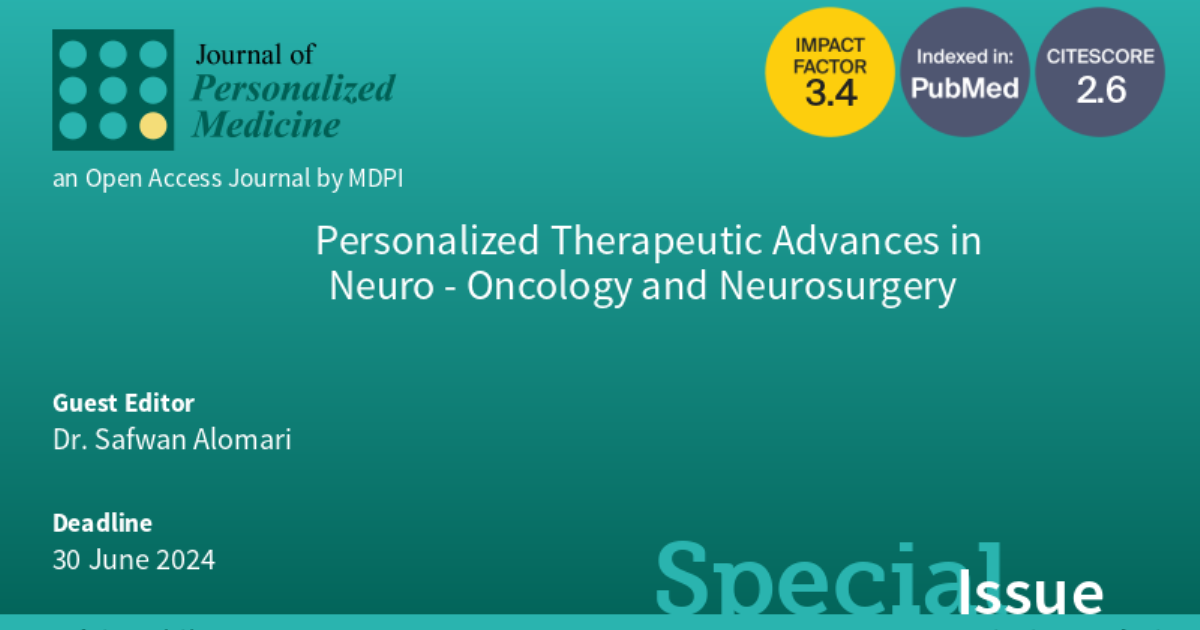- 6.0CiteScore
- 22 daysTime to First Decision
Personalized Therapeutic Advances in Neuro-Oncology and Neurosurgery
This special issue belongs to the section “Personalized Therapy and Drug Delivery“.
Special Issue Information
Dear Colleagues,
In recent years, personalized medicine has been increasingly incorporated into neuro-oncology and neurosurgery. Basic and translational research in the fields of genetics, molecular biology, transcriptomics, proteomics and metabolomics play a crucial role in the diagnosis and treatment of different diseases.
This Special Issue, entitled “Personalized Therapeutic Advances in Neuro-Oncology and Neurosurgery”, aims to discuss the prevention, diagnosis, risk assessment, personalized treatment and future trends in neuro-oncology and neurosurgery. We encourage researchers (clinicians and scientists) in these fields to submit original articles or reviews to this Special Issue of the Journal of Personalized Medicine.
Topics may include (but are not limited to) the following:
personalized medicine in glioblastomas; meningiomas; pituitary tumors; spinal cord injury; neuro-imaging; genomics, proteomic, inflammation of neurological and neurosurgical diseases; and epigenetics and microRNAs of neuro-oncology and neurosurgical diseases.
Dr. Safwan Alomari
Guest Editor
Manuscript Submission Information
Manuscripts should be submitted online at www.mdpi.com by registering and logging in to this website. Once you are registered, click here to go to the submission form. Manuscripts can be submitted until the deadline. All submissions that pass pre-check are peer-reviewed. Accepted papers will be published continuously in the journal (as soon as accepted) and will be listed together on the special issue website. Research articles, review articles as well as short communications are invited. For planned papers, a title and short abstract (about 250 words) can be sent to the Editorial Office for assessment.
Submitted manuscripts should not have been published previously, nor be under consideration for publication elsewhere (except conference proceedings papers). All manuscripts are thoroughly refereed through a single-blind peer-review process. A guide for authors and other relevant information for submission of manuscripts is available on the Instructions for Authors page. Journal of Personalized Medicine is an international peer-reviewed open access monthly journal published by MDPI.
Please visit the Instructions for Authors page before submitting a manuscript. The Article Processing Charge (APC) for publication in this open access journal is 2600 CHF (Swiss Francs). Submitted papers should be well formatted and use good English. Authors may use MDPI's English editing service prior to publication or during author revisions.
Keywords
- neurosurgery
- neuro-oncology
- brain tumor
- neuro-imaging
- glioma
- spinal cord injury
- personalized medicine

Benefits of Publishing in a Special Issue
- Ease of navigation: Grouping papers by topic helps scholars navigate broad scope journals more efficiently.
- Greater discoverability: Special Issues support the reach and impact of scientific research. Articles in Special Issues are more discoverable and cited more frequently.
- Expansion of research network: Special Issues facilitate connections among authors, fostering scientific collaborations.
- External promotion: Articles in Special Issues are often promoted through the journal's social media, increasing their visibility.
- e-Book format: Special Issues with more than 10 articles can be published as dedicated e-books, ensuring wide and rapid dissemination.

